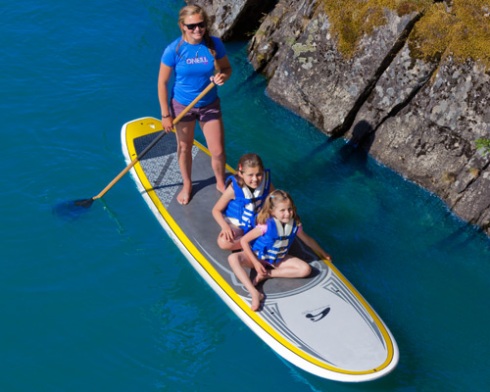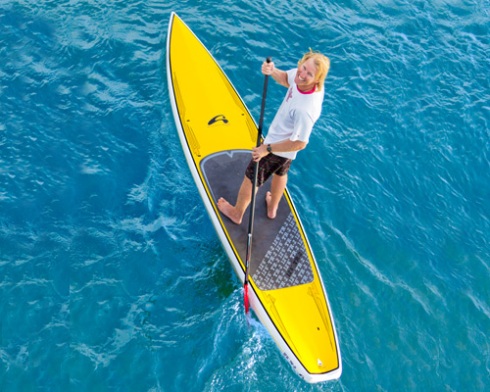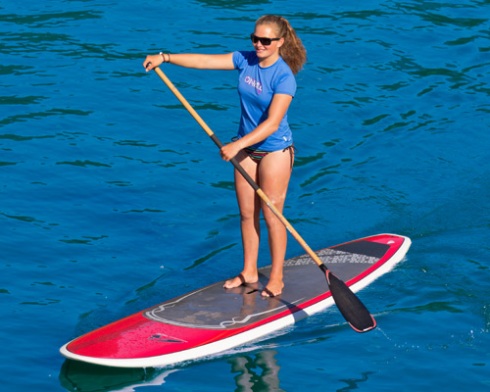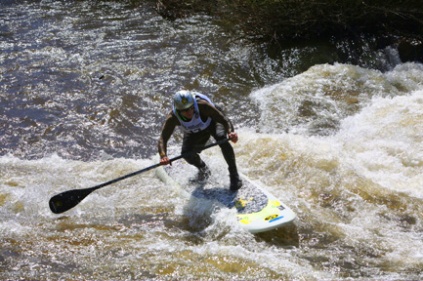With the rapid growth in the sport of paddleboarding we have seen an explosion in the range of paddleboards available to us. In order to help us choose the right board we need to ask ourselves a couple of questions. Where am I going to paddle and how am I going to paddle?
In terms of where am I going to paddle the possible answers may be Flat water, open ocean, waves and surf or rivers. Lets look at each of these options and consider the boards best suited to them while also considering the how am I going to padde question at the same time.
Flat water boards
This would be considered anywhere you intend to paddle board while not trying to catch and ride waves such as calm rivers, lakes and bays. Typical board sizes range from 10′-12’in length for recreational paddlers and 12’6 to 14′ for long distance or speed oriented paddlers. The typical shape of a recreational SUP board for flat water is very similar to a surfboard longboard; round nose, wide outline and a square tail. The longer the board the more surface area on the water and the better it will glide over the water for faster overall paddle speed. You may prefer to sacrifice some of the speed for a shorter board to make it easier to handle in and out of the water. If you are looking for a more specialized board for touring or racing then it will have quite a different shape having a more pointed bow with a finer entry and more of a keel shape. If you are looking for speed and a more athletic workout then choose a longer board.Here is a longer general purpose board suitable for carrying larger paddlers or more than one paddler, this board is very stable and is often used for the growing sport of SUP fishing.
Whereas this board is a race/touring board showing the different shape. These boards are much faster through the water but may feel less stable due to their narrower width. They are also much less maneouverable than other boards making them less suitable for surfing.
Moving water boards.
If you are looking for a board to surf with then like in regular prone surfing there are a lot of different shapes and sizes of boards for different styles of surfing. The smaller and less volume the board has the more maneuverable the board will be allowing for more aggressive surfing. A true surf model SUP will be in the 8’0 – 10’6 size range with shapes mimicking those of surfboards from short boards with pointed noses to longboards. Typically the less volume to the board the more maneuverable, responsive and performance oriented the board will be. Of course it still needs to float you while paddling standing up.Surfing SUPs will generally have more rocker to make them more maneouverable on the waves. here is an example of a 10’6″ board suitable for surf.
Increasingly SUP’s are starting to be seen on white water rivers, the standing position giving excellent vision for reading the water. This is where inflateable boards really come into their own both in terms of ease of transportation to the river and less likelihood of damage when hitting rocks. These boards tend to be shorter and have enough rocker to make them easily maneouverable around obstacles.
How big a board do I need?
The size of board will depend upon what you want the board to do as we discussed above and your weight. Most board manufacturers will print a weight range for each of their boards which you can use to choose the best board for you, but a good rule of thumb is to look at the volume of the board in litres and compare that to the equivalent weight in pounds so a board of 220 litres would be suitable for someone up to around 220 lbs.
What about fins?
Boards come with a varying number of fins depending upon the use you intend to put them to
Single Fin: Many paddle boards will have one large fin directly in the back center of the board near the tail. This large fin which can range anywhere from 8-10″ in length helps to track the board on the flatwater or face of the wave while surfing.
2 Plus 1: This is a very common type and usually includes a large single fin 8-10″ tall in the center and 2 small side fins 3-4″ in tall on the left and right. The side fins help the board track better through turns while surfing on the face of the wave and help the tail hold the wave face.
Quad Fins: Quad fins are 4 fins total with a large and small fin mounted along the rail on both sides of the tail. Quad fins help the board drive in slow spots due to the lack of drag from a center fin and also help the board grip and track on hollow waves since the fins are situated along the rail line.
So there you have a brief guide to different paddle boards if you need more information or help come in and we can help you choose the right board for you




